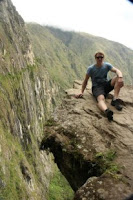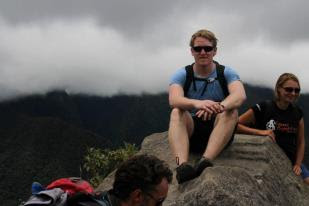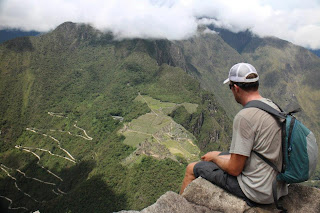See more pictures from our trip on Facebook.
We just finished our four day hike yesterday to Machu Picchu so while the memories are still fresh (and my legs still ache from the climb) I thought I should quickly fill you all in.
We arrived in Lima on the 12th of March, awaiting my brother Dara’s arrival on the 19th. Lima is a really cosmopolitan city and not at all what we expected after travelling in other Central and South American counties. We stayed in Miraflores, a wealthy part of the city near the beach, not unlike Venice beach in California. Kids go around on skateboards and shops sell rediciously priced clothes that already come sun bleached and beach ready. Really nice spot, but a little pricey for two cost-conscious travellers.

Dara flew in on the Tuesday and on the Wednesday morning we flew to Cusco, the capital of the old Inca Empire. Cusco is over 4,000 ft above sea level, so altitude sickness is common and everyone feels a little out of breath for the first few days. While Cusco was the most important Inca city, what remains now is a really cute spanish colonial town. When the Spanish arrived in 1533, they destroyed all the temples in a bid to convert the locals (it also provided cheap materials for their new town) and Cuzco now has many large churches with impressive squares throughout the city.
While Cuzco is nice, it is very touristy and you can’t walk a metre without being bombarded by people selling tours to Machu Picchu. We chose the Inka Jungle Trek as it is half the price of the classic Inca trail, includes loads of other activities, and has hostel accomodation each night instead of a tent so you arrive half-rested to take on Machu Picchu on the fourth day.
Jungle Trek – Day 1 – Cuzco to Santa Maria
After a 6 o´clock breakfast we, along with the nine others on our tour, headed to Habra Malaga, a mountain over 4,300 metres over sea level. to begin the mountain biking leg of our trip. It was a cloudy morning and at the height we were at we couldn’t see much beyoung a few feet. Despite this it was great fun free wheeling downhill for two hours at around 30 kph, through streams and around hair pin turns. Once we dropped below the cloud line the sun came out and it turned into a lovely day. Matt, with his prior experience of mountain biking, finished up first out of the 12 of us. I finished a passable 7th while Dara literally pipped me at the post and finished 6th. After lunch we headed up to the Andean town of Santa Maria, where we randomly ended up playing American Football with the local kids. After dinner and a few games of cards we headed to bed in peparation of the 8 hour hike the next day.
Day Two – Santa Maria to Santa Teresa
On day two, we followed the Urubamba River from the town of Santa Maria to Santa Teresa. After a quick spin in the back of a four wheel drive we began our trek through some local farms. When I say local farms, you probably envision rolling hills and large fenced in paddocks, but farming up in the Andes is completely different. Small farm houses cling to a mountain side covered in jungle. In parts where the land is (slightly) less steep, small fields of coca and coffee grow – the most profitable of the crops grown here.



Mangos, avacados and bananas also grow in abundance but don’t return anywhere near as much profit. Coca leaves, the main ingredient of cocaine was made illegal to grow in 2009, but a major out-cry forced a turn around. Locals use the plants for remedial and social purposes – chewing dried coca leaves is as common as drinking tea in Ireland. Coca tea is also a great remedy for altitude sickness and tastes pretty good with some sugar. Along our trek we also called into a typical farm house, where over 20 guinea pigs were running around the dirt floor kitchen. On first glance you may mistake them for pets, but in Peru cuy (guinea pigs) are treated like chickens are in other parts of the world and while they are fed scraps and allowed to run around the kitchen as they please they are still ending up just like the chickens, in the pot. Cuy is a delicacy here which Dara ordered his first night here. We all had a try and once you get over any psychological issues you may have it actually tastes very good.
For two hours of the trek we used an origianal Inca trail which as a narrow path built into a cliff face. The views were amazing but you couldn’t help question the sanity of the Inca who chose to build up and along the sheer Andean mountains and not down in the valleys. The Incas however understood the dangers of floods and of land slides which is why they constructed their famous terraces. Almost at the end of our long day of treking we got to a part of the river where the bridge had been washed away. The locals had replaced the bridge with a rudementry cable car which spanned the river for 50 metres, 25 metres above the raging water. To call the crossing a cable car is very generous as it bore more resemblance to a lazy waiter, just a wooden tray big enough for two people to sit on attached to the cable by a Y frame.


Ropes were attached to either side and a local man would pull the contraction across by a system of rope and meter rings. Probabelly one of the craziest things I have done in my life! Following the cable car adventure we reached the beautiful hot springs just outside Santa Thresa. The pools are built into the mountain with low other walls creating an almost affinity pool effect. As we soked our tired muscles the full moon popped out from behind the clounds to create a perfect end to a perfect day.
Day 3 – Santa Teresa to Aguas Calientes
Day three started with zip lining along the highest and longest line in South America. The Sacsara Valley creates the perfect play ground for this kind of adventure with cables linking one steep valley wall to the another, with the Santa Teresa river rumbling below reminding you of just how high you really are.

Once we had our adrenaline fix we headed by bus to the hydroelectric plant which feeds Cusco and soon most of the southern part of Peru. With the snow melt from the mountins, the four months of continual rain during the wet season and the many tributeries which join at this point it is easy to imagine how that amount of energy can be produced. The pressence of this river and the surrounding mountains was also the reason why the Incas chose this location for the building of Machu Picchu. We actually had our first glance of Machu Picchu from a spot not far from the hydroelectric plant, as we walked along the last leg of our trek to Aguas Calientes.

The view of Machu Picchu nestled high up in the Machu Picchu Mountain spurred us on and we arrived in Aguas Calientes just after 5.30pm. This just gave us enough time to shower, grab a quick meal and stock up on water before crawling into bed at 10pm. The alarms were set for 4pm, ready for the one and a half hour trek up to Machu Picchu in the morning, in a bid to beat the masses to the 6am opening.
Day 4 – Machupicchu and Huaynapicchu
After a quick breakfast we set off by tourch light for Machu Picchu. Anyone who has done this will understand the strange feeling we had joining others on the silent dark march towards the Lost Inca City. Our fitness did us proud on the 1,726 steps, with Dara being the second climber to reach the gates, followed closely by four of us from the Jungle Trek. The buses had started to arrive with those not up to the climb and by 6am when the gates opened the atmosphere more closely resembeled that of a concert with the crowd anxiously awaiting the first glimpse of the star.

The ruins of Machu Picchu are beautiful but it is the lcoation which really makes it so special. The clouds rolled through the valley for the first two hours creating a stange mystical effect where the ruins would completely disapear only to reappear again a few minutes later. I won´t go into great detail as in this case pictures speak more than words. we couldn´t have had a better day in terms of weather and once the few initial clouds cleared, the sun shone all day. Considering we are still technically in the wet season we were extremely lucky to have four days of near continuious sunshine. Including the walk up and down to the site, the walk up Huaynapicchu (the moutain you can see in the background of most pictures of Machu Picchu), the hike to the Inca bridge and the hike to the Sun Gate, we barely stopped for 11 hours. I know it seems sentimental to say but the site does seems to invigorate you and you find you have more energy than you thought possible. We are definately feeling a little sore and stiff today but are still totally in awe of our four amazing days of hiking to Maccu Picchu.
See more pictures from our trip on Facebook.




















